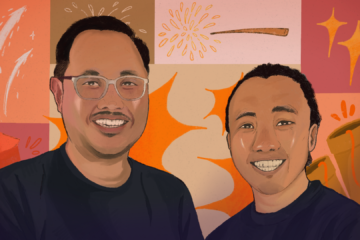Editor’s note: This article was originally published in Vol. 49, Issue No. 4 of The Flame on P.Y. 2013-2014.
WHEN IT comes to student activism, there is no doubt that the Faculty of Arts and Letters (AB) is home to the most vocal and dynamic majors.
From complaints about the school facilities to pressing sociopolitical issues today, Artlets have been raising their voices and throwing their arguments to prove their points. But lately, it seems students have lost touch and become “apathetic” because of loss of interest in active participation.
William Shakespreare’s Hamlet bothered us with the question, “To be or not to be?” to ponder about life and death, but for Artlets, the question is whether they act dignifiedly on a problem or not at all, shrugging off their shoulders and walking away.
Tracing the radical roots
Upon establishing the Arts and Letters Student Council (ABSC) in 1964, students had become more confident in expressing themselves.
Later on, political parties, such as the Students’ Democratic Party (SDP, est. 1981); DEKADA (formerly Dekada Nobenta, est. 1992); Grand Alliance for Progress (GAP, est. sometime after 2000); and the Alliance of Concerned Thomasians (ACT-Now!, est. 2006) were formed to better address the students’ rights and freedom.
During the first several years after the establishment of each organization, Artlets were highly involved in the practice of student activism.
The Flame’s archives (1969-1990s) featured students who boldly talked about their insights regarding various issues, including the Filipinization of the positions in the University’s administration (1970), the courses offered by the faculty (1970s), violent versus non-violent ways of protests (1971) and Martial Law (1971-1981).
A column from an archive (Vol. VI, No. 5, March 1970) called Seven Guys Talk on Student Activism by Maloy and Madeleine quoted, “Activism is a healthy sign that has propelled student and youth groups into national prominence, a prominence which everybody has to reckon with.”
Political science alumna Myrna Solla admitted on Three Campus Rebels by Art I. Dialogo (March 1971) that she will not hesitate to help the oppressed and adhere to violent ways if all the peaceful means were exhausted. Other articles and featured students shared the same insights about the students’ involvement in print and through movements.
What was then a vivid picture of “practicing students’ freedom of expression,” however, was said to be not so obviously seen today. Did that fire simply die away with time?
Are you bold enough?
Activism, as most people see it, is voicing out a stand against an important national issue, usually done in rallies. But because of the many avenues today that resolve issues, student activism has changed and molded into modernity.
“You can be active in a different context,” said political science instructor Amr Sison. “Ang tingin kasi ng iba ‘pag sinabi mong aktibismo, you call for radical, 360 degrees change.”
He added that activism is greatly affected by the things happening in the environment and is influenced by the broader problems faced by the country.
Angelica Naca, GAP Chairperson, shared, “Nowadays, people tend to be smarter and more calculated. During and after the Martial Law, sobrang daming nag-ra-rally kasi sobrang sabik sila sa freedom.”
SDP Chair Nicky Galang also thought the same thing by saying that the reason why people were bolder before was because there was really something to be bold about.
While for sociology Asst. Prof. Froilan Alipao, he observed that in terms of number, activists from different campuses has declined due to the change in the subculture of youth students brought about by globalization.
This would explain why it seemed that Artlets then were seen as “bolder” or “more active” compared to the way the current generation reacts to social and political problems. During the 1970s to early 2000s, there was a huge pot of issues boiling the country: corruption, increase in tuition fees, price hike, inflationthese series of negative experiences, Sison said, pushed everyone into supporting activism.
Today, though these dilemmas still exist, it is not as aggravating as it was before, that is why there are smaller and “less violent” activist groups.
The so-called culture of apathy
Though both the chairpersons of the political parties and the professors asked had different views on the “culture of apathy” of Artlets, they all had their plausible reasons.
Naca confessed she could feel the student’s apathy, but takes it as a challenge for the part of political parties.
Alipao said that there are a lot of students in AB who have become apathetic. Though he suggested that activism would become more alive if there were a hint of academic nature in the causes in order to give the students a little push.
While both Galang and DEKADA Chairperson Ram Meria disagreed with the claim, they both pointed out that activism must always be in line with the willingness of the student.
Newly-elected ABSC President Majann Lazo also disagreed and added the level of awareness of Artlets in terms of sociopolitical issues should be widened for them to act on it.
So, are the students really apathetic? It is said that when a person is involved or can relate to a topic, he will actively seek information and expend more cognitive effort to process it. As per Lo, Ven-hwei on 1994, when there is no relation or involvement, there is no motivation to gather information.
In connection to Sison’s explanation earlier, “Technically, people now, hindi naman sila apathetic. Hindi lang sila nauudyok ng mga pwersa sa paligid nila.”
The dawn of a new generation
Whether AB students are apathetic or not, there is always a way to make things clearer and better.
All four political parties offer constant communication and various ways of reaching out to members and non-members for the Artlet community to be more aware and interested in their causes.
Professors also have a huge role in helping the students understand the broad idea of activism. According to Alipao and Sison, though each professor might have his or her own beliefs on the idea of activism, their general role is to facilitate social transformation through liberating education, and to create a solid opinion for students—opinions that are based on solid analysis, facts and data.
The so-called culture of apathy cannot be easily concluded. Either way, whatever hot topic is placed on deck, Artlets always has something to say. F



